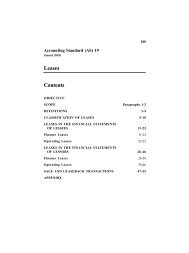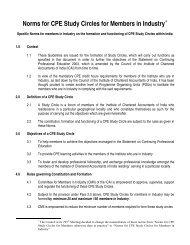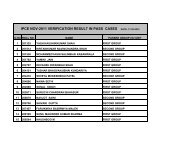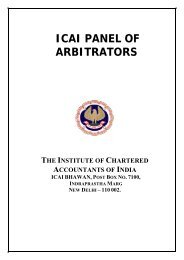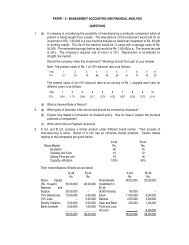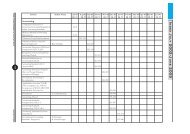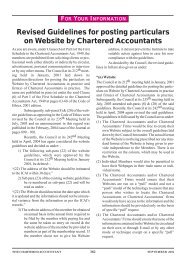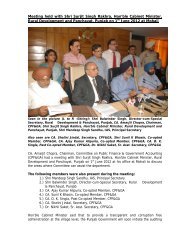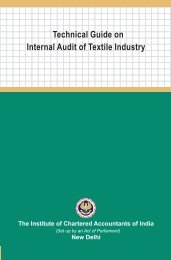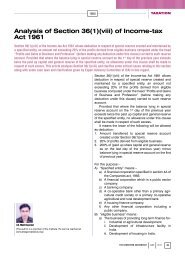The Chartered Accountant
The Chartered Accountant
The Chartered Accountant
You also want an ePaper? Increase the reach of your titles
YUMPU automatically turns print PDFs into web optimized ePapers that Google loves.
inspection are complete. However,<br />
revenue is recognised immediately<br />
upon the purchaser’s<br />
acceptance of delivery when:<br />
(i) <strong>The</strong> installation process<br />
is simple in nature; or<br />
(ii) <strong>The</strong> inspection is performed<br />
only for purposes<br />
of final determination<br />
of contract prices.<br />
(b) On approval when the purchaser<br />
has negotiated a limited<br />
right of return<br />
If there is uncertainty about<br />
the possibility of return, revenue<br />
is recognised when the<br />
shipment has been formally<br />
accepted by the purchaser or<br />
the goods have been delivered<br />
and the time period for rejection<br />
has elapsed.<br />
(c) Consignment sales under<br />
(d)<br />
which the recipient (purchaser)<br />
undertakes to sell the<br />
goods on behalf of the shipper<br />
(seller)<br />
Revenue is recognised by the<br />
shipper when the goods are sold<br />
by the recipient to a third party.<br />
Cash on delivery sales<br />
Revenue is recognised when<br />
delivery is made and cash is received<br />
by the seller or its agent.<br />
13. Lay away sales under which the<br />
goods are delivered only when the<br />
purchaser makes the final payment in<br />
a series of installments<br />
Revenue from such sales is recognised<br />
when the goods are delivered. However,<br />
when experience indicates that<br />
most such sales are consummated,<br />
revenue may be recognised when a<br />
significant deposit is received provided<br />
the goods are on hand, identified and<br />
ready for delivery to the purchaser.<br />
14. Orders when payment (or partial<br />
payment) is received in advance of delivery<br />
for goods not presently held in<br />
inventory, for example, the goods are<br />
still to be manufactured or will be delivered<br />
directly to the customer from a<br />
third party<br />
Revenue is recognised when the goods<br />
DECEMBER 2008 1078 THE CHARTERED ACCOUNTANT<br />
STANDARDS<br />
are delivered to the purchaser.<br />
15. Sale and repurchase agreements<br />
(other than swap transactions) under<br />
which the seller concurrently agrees to<br />
repurchase the same goods at a later<br />
date, or when the seller has a call option<br />
to repurchase, or the purchaser<br />
has a put option to require the repurchase,<br />
by the seller, of the goods<br />
<strong>The</strong> terms of the agreement need to<br />
be analysed to ascertain whether, in<br />
substance, the seller has transferred<br />
the risks and rewards of ownership<br />
to the purchaser and hence revenue<br />
is recognised. When the seller has<br />
retained the risks and rewards of<br />
ownership, even though legal title has<br />
been transferred, the transaction is a<br />
financing arrangement and does not<br />
give rise to revenue.<br />
16. Sales to intermediate parties, such<br />
as distributors, dealers or others for<br />
resale<br />
Revenue from such sales is generally<br />
recognised when the risks and rewards<br />
of ownership have passed. However,<br />
when the purchaser is acting, in substance,<br />
as an agent, the sale is treated<br />
as a consignment sale.<br />
17. Subscriptions to publications and<br />
similar items<br />
When the items involved are of similar<br />
value in each time period, revenue<br />
is recognised on a straight line basis<br />
over the period in which the items are<br />
dispatched. When the items vary in<br />
value from period to period, revenue<br />
is recognised on the basis of the sales<br />
value of the item dispatched in relation<br />
to the total estimated sales value of all<br />
items covered by the subscription.<br />
18. Installment sales, under which the<br />
consideration is receivable in installments<br />
Revenue attributable to the sales price,<br />
exclusive of interest, is recognised at<br />
the date of sale. <strong>The</strong> sale price is value<br />
of the consideration, determined by<br />
discounting the installments receivable<br />
at the imputed rate of interest.<br />
<strong>The</strong> interest element is recognised as<br />
revenue as it is earned, on a time proportion<br />
basis that takes into account<br />
the imputed rate of interest.<br />
19. Real estate sales<br />
Revenue is normally recognised when<br />
legal title passes to the purchaser.<br />
However, where the equitable interest<br />
in a property may vest in the purchaser<br />
before legal title passes and therefore<br />
the risks and rewards of ownership<br />
have transferred at that stage. In such<br />
cases, provided that the seller has no<br />
further substantial acts to complete<br />
under the contract, it may be appropriate<br />
to recognise revenue. In either<br />
case, if the seller is obliged to perform<br />
any significant acts after the equitable<br />
and/or legal title, revenue is recognised<br />
as the acts are performed. An<br />
example is a building or other facility<br />
on which construction has not been<br />
completed.<br />
In some cases, real estate may be sold<br />
a degree of continuing involvement by<br />
the seller such that the risks and rewards<br />
of ownership have not been transferred.<br />
Examples are sale and repurchase agreements<br />
which include put and call options,<br />
and agreements whereby the seller<br />
guarantees occupancy of the property<br />
for a specified period, or guarantees a<br />
return on the purchaser’s investment<br />
for a specified period. In such cases, the<br />
nature and extent of the seller’s continuing<br />
involvement determines how the<br />
transaction is accounted for. It may be<br />
accounted for as a sale, or as a financing,<br />
leasing or some other profit sharing<br />
arrangement. If it is accounted for as<br />
a sale, the continuing involvement of<br />
the seller may delay the recognition of<br />
revenue.<br />
A seller must also consider the means<br />
of payment and evidence of the purchaser’s<br />
to complete payment. For<br />
example, when the aggregate of the<br />
payments received, including the purchaser’s<br />
initial down payment, or continuing<br />
payments by the purchaser,<br />
provide insufficient evidence of the<br />
purchaser’s commitment to complete<br />
payment, revenue is recognised only<br />
to the extent cash is received.<br />
Interest, Royalties and Dividends<br />
20. License fees and royalties<br />
Fees and royalties paid for the use of<br />
an entity’s assets (such as trademarks,<br />
patents, software,) are normally recog-



